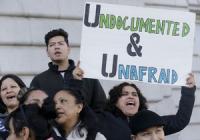-
ACLU issues Texas “travel advisory”

The American Civil Liberties Union (ACLU) issued a “travel alert” informing anyone planning to travel to Texas in the near future to anticipate the possible violation of their constitutional rights when stopped by law enforcement. The ACLU says that the alert comes amid the passing of a Texas law known as SB4. The law gives a green light to police officers in the state to investigate a person’s immigration status during a routine traffic stop, leading to widespread racial profiling, baseless scrutiny, and illegal arrests of citizens and non-citizens alike presumed to be “foreign” based on how they look or sound.
-
-
Lawsuit over sanctuary cities bill is just a matter of time, opponents say
The question isn’t whether or not the Texas attorney general’s office will be hauled to court over a Texas Senate bill to ban “sanctuary” policies in Texas — but, more likely, when they’ll be asked to defend Senate Bill 4 (SB4) in a federal court. The legislation makes sheriffs, constables, police chiefs and other local leaders subject to a Class A misdemeanor and possible jail time if they don’t cooperate with federal authorities and honor requests from immigration agents to hold inmates who are subject to deportation. It includes civil penalties for entities that violate the provision that begin at $1,000 for a first offense and climb to as high as $25,500 for subsequent infractions. It also applies to public colleges.
-
-
U.S. border agents illegally turning away asylum seekers at U.S. border: Report
Human Rights First on Wednesday released a new report documenting dozens of instances in which U.S. border agents illegally turned away asylum seekers from the U.S. southern border. “We’ve documented dozens of cases in which individuals seeking protection from violence and persecution have been unlawfully turned away. These actions by U.S. border agents not only violate U.S. laws and treaty commitments, but put individuals’ lives in danger by sending them into the hands of persecutors, traffickers, or cartels,” said the lead researcher on the report.
-
-
How crossing the U.S.-Mexico border became a crime

It was not always a crime to enter the United States without authorization. In fact, for most of American history, immigrants could enter the United States without official permission and not fear criminal prosecution by the federal government. That changed in 1929. On its surface, Congress’s new prohibitions on informal border crossings simply modernized the U.S. immigration system by compelling all immigrants to apply for entry. However, in my new book City of Inmates, I detail how Congress outlawed border crossings with the specific intent of criminalizing, prosecuting, and imprisoning Mexican immigrants.
-
-
DHS launches new Office for victims of illegal immigrant crime
Homeland Security secretary John Kelly the other day announced the official launch of the U.S. Immigration and Customs Enforcement (ICE) Victims of Immigration Crime Engagement Office (VOICE). The VOICE office will assist victims of crimes committed by criminal aliens. ICE built the VOICE office in response to the Executive Order entitled Enhancing Public Safety in the Interior of the United States, which directed DHS to create an office to support victims of crimes committed by criminal aliens.
-
-
Germany: Rise in crimes committed by foreigners -- and in crimes by right-wing extremists

Earlier this week Germany’s Interior Ministry released the 2016 police crime statistics, including statistics of politically motivated crime. Compared to 2015, the number is up by 6.6 percent and has reached a new high. The main factor is the soaring number of politically motivated crimes by foreigners, which has risen by 66.5 percent to a total of 3,372 offenses. The backlash against the large number of migrants allowed into Germany in 2015 and 2016 manifests itself in crime statistics as well: While the number violent offenses motivated by left-wing extremism fell by 24.2 percent, the number of violent offences committed by right-wing extremists rose by 14.3 percent.
-
-
Local, federal focus on deadly gang violence on Long Island
There has been a surge since 2014 in the number of unaccompanied minors coming to the United States, mostly from El Salvador, Guatemala, and Honduras. Most of the minors are entitled to federal anti-trafficking protections, and subsequent resettlement. Suffolk Country is ranked fourth in the U.S. in the number of unaccompanied minors resettled in the county, and neighboring Nassau County ranks tenth. Violent gangs such as MS-13 actively recruit these unaccompanied minors. Local and federal leaders say there is a need to do more – from better vetting to gang prevention programs to better law enforcement – to address the growing gang violence.
-
-
Does cooperating with ICE harm local police? What the research says

Police need public cooperation. The police rely on the public to report and help solve crimes. This is especially true now that police departments face budget cuts and increasing demands on their time – an environment that pressures police to get things done through innovative partnerships with citizens. But cooperation and partnerships rely on trust, something that’s in short supply between citizens and police. A tough stance toward enforcing immigration laws can make immigrants, as well as the general public, cynical toward police, weakening their trust and legitimacy. Police are right when they say forcing them to work with ICE will make their job harder.
-
-
Sharp increase in number of non-criminal undocumented immigrants arrested by ICE
The number of immigrants with no criminal records arrested has more than doubled under President Donald Trump. Immigrations and Customs Enforcement made 21,362 arrests from January to mid-March, which is an increase of roughly one-third compared to 16,104 during the same period last year. The number of non-criminals arrested doubled to 5,441, suggesting Trump’s administration is enforcing immigration laws more aggressively than the previous administration.
-
-
The face of Latin American migration is rapidly changing. U.S. policy isn’t keeping up
A fundamental shift in U.S. immigration patterns is well underway. Recent rhetoric from President Donald Trump and the focus of U.S. immigration policies suggest that Mexicans entering the U.S. without authorization are the principal challenge facing policymakers. That is no longer the case. The era of Mexico as the primary source of immigrants to the U.S. appears to be coming to a close. An increasing number of individuals are now arriving at the U.S. southwest border because of crime, violence and insecurity in Central America. These are now far more decisive factors in decisions to emigrate than the traditional pull of economic opportunity in the U.S. This change in the profile of those arriving at the border suggests two things. First, far more emphasis should be placed on improving the U.S. immigration court system than on efforts to strengthen an already well-fortified border. Second, there is a need to move beyond a view of those arriving at the U.S. southwest border as a monolithic group driven by purely economic motives.
-
-
Trump likely to eye treaties, E-Verify as part of immigration strategy
The Trump administration may not be able to move mountains — literally — in its quest to build a coast-to-coast wall along the nation’s southern border. But that doesn’t mean the White House won’t review some long-standing treaties that have stymied past administrations in their efforts to erect such barriers, Former immigration and border officials say the Trump administration is floating ideas that range from nullifying treaties to expanding employment screenings.
-
-
Educating children in Guatemala before they decide to migrate to the U.S. border

Insecurity is a primary factor pushing thousands of young Central Americans to leave their homes and travel north. In fiscal year 2016, nearly 60,000 youth from Central America and Mexico crossed the U.S. border without a parent or guardian. During the peak of the crisis in 2014, more than 68,000 made the perilous trek. The vast majority of these minors are arriving from what are called Northern Triangle countries in Central America: Guatemala, Honduras and El Salvador. U.S. foreign policy in Central America has focused on funding a militarized war on drugs, which in turn has fueled the root causes that push people to migrate. But some efforts have been made to identify and address these root causes. In 2014, the U.S. government committed $9.6 million in emergency funding to El Salvador, Guatemala and Honduras to assist migrants returned from the U.S. USAID launched a five-year, $40 million program to improve security in Guatemala. Programs that strengthen the regional socioeconomic fabric of affected communities stand as alternatives to anti-drug operations. These programs could establish conditions for children and youth to stay in their countries of origin and live more productive and healthy lives.
-
-
U.S. crime rates declined in period of high immigration: Reports

The number of immigrants in the United States has risen from 3.5 million in 1990 to 11.1 million in 2014, but two new studies show that an increased number of immigrants in the country might have been associated with a historic decline in crime rates. The studies – Immigration and Public Safety from the Sentencing Project and Criminal Immigrants Their Numbers, Demographics, and Countries of Origin from the CATO Institute — also shows that immigrants are less likely than U.S.-born citizens to commit crimes and be imprisoned.
-
-
Trump’s revised travel ban still faces legal challenges

President Trump’s new executive order on immigration addresses some of the legal problems found by courts in the Jan. 27 original order, but is still vulnerable on some of the same legal grounds. As a constitutional law professor who has recently written on this topic, I’d contend that Trump’s lawyers are not out of the woods yet. Ultimately, the only way to know for sure the legal effect of this new executive order is to wait for a court ruling. Given that the American Civil Liberties Union has already pledged to challenge the new executive order in its ongoing litigation against the immigrant ban, we may not have to wait long.
-
-
Mexico, rejecting Trump’s scheme, will only accept deportees who are Mexican nationals

A key element in President Trump’s deportation scheme is the deportation to Mexico of everyone crossing the U.S.-Mexico border illegally, regardless of the deportee’s nationality. The deportation scheme indicates that the United States expects Mexico to build detention facilities for the hundreds of thousands which will be deported. Mexican officials, in meetings with Rex Tillerson and John Kelly last Thursday, said that Mexico would not, under any circumstances, agree to accept and hold deportees who are not Mexican nationals.
-
- All
- Regional
- Water
- Biometrics
- Borders/Immig
- Business
- Cybersecurity
- Detection
- Disasters
- Government
- Infrastructure
- International
- Public health
- Public Safety
- Communication interoperabillity
- Emergency services
- Emergency medical services
- Fire
- First response
- IEDs
- Law Enforcement
- Law Enforcement Technology
- Military technology
- Nonlethal weapons
- Nuclear weapons
- Personal protection equipment
- Police
- Notification /alert systems
- Situational awareness
- Weapons systems
- Sci-Tech
- Sector Reports
- Surveillance
- Transportation
Advertising & Marketing: advertise@newswirepubs.com
Editorial: editor@newswirepubs.com
General: info@newswirepubs.com
2010-2011 © News Wire Publications, LLC News Wire Publications, LLC
220 Old Country Road | Suite 200 | Mineola | New York | 11501
Permissions and Policies
Editorial: editor@newswirepubs.com
General: info@newswirepubs.com
2010-2011 © News Wire Publications, LLC News Wire Publications, LLC
220 Old Country Road | Suite 200 | Mineola | New York | 11501
Permissions and Policies
